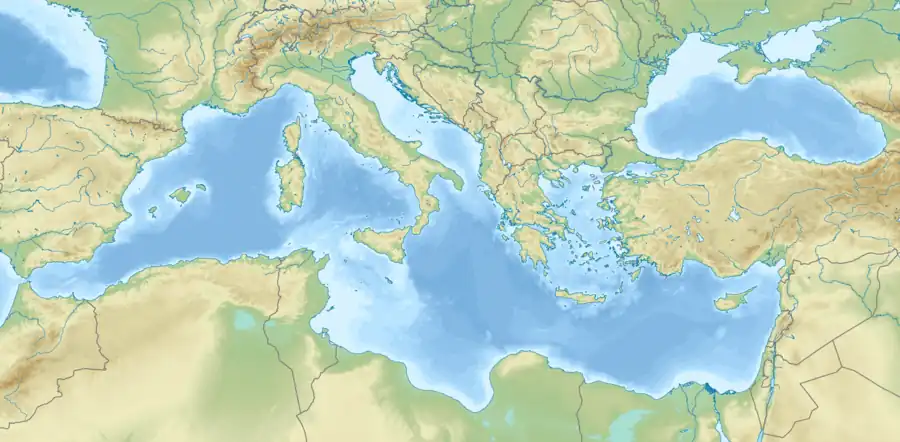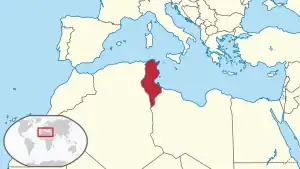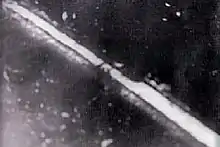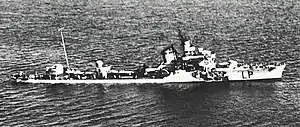| Battle of the Tarigo Convoy | |||||||
|---|---|---|---|---|---|---|---|
| Part of the Battle of the Mediterranean of World War II | |||||||
 Relief map of the Mediterranean Sea | |||||||
| |||||||
| Belligerents | |||||||
|
|
| ||||||
| Commanders and leaders | |||||||
| Philip Mack | Pietro de Cristofaro † | ||||||
| Strength | |||||||
|
4 destroyers 2 reconnaissance aircraft |
3 destroyers 4 merchant ships 1 ammunition ship 1 reconnaissance aircraft | ||||||
| Casualties and losses | |||||||
|
43 killed 1 destroyer sunk |
350–1,800 killed 2 destroyers sunk 1 destroyer beached 4 cargo ships sunk or destroyed | ||||||
The Battle of the Tarigo Convoy (sometimes called the Action off Sfax) was a naval battle of the Second World War, part of the Battle of the Mediterranean. It was fought on 16 April 1941, between four Royal Navy destroyers and three Italian destroyers of the Regia Marina which were escorting a convoy near the Kerkennah Islands off Sfax, on the Tunisian coast. The battle was named after the Italian flagship, the destroyer Luca Tarigo.
Control of the sea between Italy and Libya was important to both sides to protect their convoys and attack those of their opponent. Axis convoys to North Africa supplied Italian colonists and German and Italian military forces. British attacks came from Malta, also dependent upon convoys for supplies.
Background
Italian convoys

The usual route for Italian convoys from Italy to Libya was round the west of Sicily and down the Tunisian coast to Tripoli with occasional excursions to Benghazi. Some supplies delivered to Tripoli were then loaded onto coasters and carried eastwards to the smaller ports along the Libyan shore to reduce the pressure on the Italian road transport system; some coasters had been attacked and sunk by British submarines. The route through Tunisian coastal waters was about 400 nmi (460 mi; 740 km) for which fighter escort in the central part of the journey was difficult to provide so it was usually traversed at night. Convoys often comprised four Italian or German ships and sailed at two-to-three day intervals, German ships transporting German troops and equipment. Escorts were provided by the Regia Marina (Italian Royal Navy) and was organised by the Italian naval authorities. The move of the German 5th Light Motorised Division began at the start of February 1941 and by March fifteen convoys had arrived carrying 25,000 men, 8,500 vehicles and 26,000 long tons (26,000 t) of supplies and equipment. By late May the 15th Panzer Division had arrived and the movement of Italian troops resumed.[1]
Malta

By March 1941, the Commander-in-chief of the Mediterranean Fleet, Sir Andrew Cunningham, believed that the Axis air threat to Malta had receded, due to Axis air losses and the diversion of Fliegerkorps X to the Balkans. The first twelve new Hurricane Mk II fighters had arrived at Malta during Operation Winch, which were faster than the Mk I and could carry long-range fuel tanks. On 8 April, Cunningham ordered a Malta Striking Force to be formed, the four most modern destroyers in the Mediterranean Fleet were to sail to Malta and begin operations against Axis supply convoys. The force comprised the J-class destroyers (1,690 tons) flotilla leader HMS Jervis (Captain Philip Mack, the commander Captain (D) of the 14th Destroyer Flotilla, Janus (Commander J. A. W. Tothill), both carrying eight 4.7-inch guns and ten torpedo tubes and the Tribal-class destroyers (1,870 tons) Nubian (Commander R. W. Ravenhill) and Mohawk (Commander J. W. M. Eeaton) armed with eight 4.7-inch guns and four torpedo tubes; all but Jervis were equipped with radar.[2]
British destroyer sorties
Until February 1941 Allied ships and aircraft were not allowed to attack isolated ships or small groups without escorts beyond 30 nmi (35 mi; 56 km) of the Libyan coast or if the ships were believed to be Italian, further than 30 nmi (56 km; 35 mi) from any Italian land. Axis ships could sail in Tunisian territorial waters, immune from attack. On 5 February, British forces were given permission to attack Axis ships on sight south of Malta and later in the month this was extended to include most of the central Mediterranean; the Admiralty also announced early in March that British ships would enter French North African territorial waters and warned Vichy ships to remain in harbour during the night. From February to May 1941, nine German ships of 31,243 GRT were sunk and nine (54,753 GRT) damaged. Had the Axis been able to use Tunisian ports the sea journey would have been so short that British opportunities to attack Axis shipping would have been much reduced. French prevarication and the imminence of Operation Barbarossa, the German invasion of the Soviet Union, led Hitler to avoid trouble with the Vichy French authorities.[1]
Jervis and Janus sailed from Suda Bay in Crete on 10 April with Nubian and Mohawk following an hour later with two light cruisers providing cover on the night of 10/11 April; the journey was unopposed and the ships docked at Malta in the morning of 11 April.[3] In the afternoon of 11 April an Axis convoy of four freighters and thee torpedo boats, which had sailed from Palermo for Tripoli, was spotted heading southwards between Lampione Island and the Kerkennah Banks, which extend about 30 nmi (35 mi; 56 km) east of Sfax, by a British reconnaissance aeroplane. The 14th Destroyer Flotilla was ordered to attack the convoy in conjunction with Fairey Swordfish aircraft of the Fleet Air Arm (FAA). Neither the ships or aircraft found the convoy and returned to Malta on 12 April. As soon as the destroyers had refuelled, they were ordered to sea after the sighting of a convoy of five merchant ships and three destroyers, which had sailed from Naples at 5:33 p.m. on 11 April and was nearing the Gulf of Hammamet. The Italians now knew of the ships based at Malta and ninety minutes after dark, aware of the shadowing Swordfish aircraft, reversed course and sailed quickly north, going round the west of Pantellaria at 2:30 a.m. on 13 April. The British ships again failed to find the convoy and two Swordfish of 830 Naval Air Squadron FAA were lost attacking the Italian ships.[3]
Prelude
Tarigo Convoy
In mid-April, 1941, a five-ship Axis convoy sailed from Naples, en route to Tripoli. It consisted of the twentieth sea-transport group of the German troopships, Adana 4,205 GRT, Arta (2,452 GRT), Ægina (2,447 GRT) and Iserlohn (3,704 GRT) and Sabaudia (1,590 GRT) an Italian ammunition ship.[4] The convoy was escorted by a Navigatori-class destroyer Luca Tarigo (flagship, Capitano di Fregata Pietro de Cristofaro, 1,628 long tons (1,654 t), armed with six 4.7-inch guns and four torpedo tubes) and the Folgore-class destroyers, Baleno (Capitano di Corvetta G. Arnaud) and Lampo (Capitano di Corvetta E. Marano) both of 1,220 long tons (1,240 t) and armed with four 4.7-inch guns and six torpedo tubes. The convoy was delayed by bad weather, sailing from Naples at 11:00 p.m. on 13 April.[5]
Malta destroyers

The British had been alerted to the convoy's sailing by intercepted radio messages. On 15 April, a British Maryland reconnaissance aircraft found the convoy and broadcast a sighting report of the composition, speed [9 kn (10 mph; 17 km/h)] and direction (south) of the convoy. AnotherMaryland was sent from Malta to observe the convoy and the 14th Destroyer Flotilla was alerted, sailing at 6:00 p.m. in rain and low cloud. There were at least six buoys arranged in a semicircle to the north, east and south-east of the Kerkennah Islands marking the shallows. The flotilla formed line ahead and increased speed to 26 kn (30 mph; 48 km/h) to get in front of the convoy near the Kerkennah Number 4 buoy. At 5:00 p.m. the convoy was spotted again by an aircraft and its composition, location, speed and course reported to Malta. The information was transmitted to Mack, which he received at 7:25 p.m. Da Cristofaro knew that the convoy had been spotted and requested fighter cover and a reconnaissance ahead of the route of the convoy. [6]
The bad weather led to the fighters being grounded and only one of two SM.79 bombers managing to take off from Syracuse at 5:15 p.m. before returning early at 6:45 p.m. without seeing the British destroyers.[7] Da Cristofaro continued towards Tripoli, not knowing that the British were at sea. At 0:44 a.m. early on 16 April, about 6 nmi (11 km; 6.9 mi) off the Kerkennah Number 4 buoy, Mack altered course to 310° with another change at 1:00 a.m. to bring the destroyers onto the opposite course of the convoy. The destroyers began to zig zag at 1:10 a.m. and the destroyers reached the predicted position of the convoy at 1:42 a.m. but the convoy was not there. mack ordered an increase in speed to 25 kn (29 mph; 46 km/h) and at 1:55 a.m. reached the place where the convoy would have been 3 nmi (3.5 mi; 5.6 km) if it had slowed to 7 kn (8.1 mph; 13 km/h) but again, nothing could be seen. If the convoy had reversed course then finding it would have been impossible so Mack assumed that it had sailed closer to the Tunisian coast and turned towards Kerkennah Number 1 buoy at 1:55 a.m. and after three minutes the convoy could be seen on a bearing of 170° about 6 nmi (6.9 mi; 11 km) way. At 1:59 a.m. Jervis signalled "Enemy in sight to port" and the destroyers began their attack.[8]
Action
At 2:00 a.m. the Destroyers changed course to 140° at 27 kn (31 mph; 50 km/h) and at 2:02 a.m. Mack signalled for torpedo-tubes to be trained to starboard. The destroyers changed course again at 2:03 a.m. to 210° to get the convoy between the destroyers and the moon, Mack ordering the destroyers to train their torpedo-tubes to port. The convoy was more distinct and comprised five ships with one large and two small destroyer escorts. Jervis commenced firing at 2:20 a.m. at Baleno which was to starboard at 2,400 yd (2,200 m) achieving hits with its man guns and pom-poms. After two minutes Janus also fired at Baleno at the same range and hit with its first salvo. The captain of Baleno and most of the officers were killed in the first salvos and the ship set on fire; the surviving crew ran Baleno onto a sandbank before it sank. Nubian opened fire at 2:20 a.m. at Sabaudia at the rear of the convoy and at the third salvo caused an explosion and a fire to start. Nubian changed targets to Iserlohn and Ægina, hitting both. At 2:23 a.m. lookouts on Nubian saw Tarigo on a reciprocal course at about 1,000 yd (910 m) on the starboard beam. Nubian accelerated towards Tarigo then away, firing with its 4.7-inch guns, pom-poms and machine-guns, hitting the bridge and the rear of the hull. Tarigo replied but fire was checked by Nubian when Mohawk turned and got in the way.[9][lower-alpha 1]
Tarigo passed down the starboard side of the British destroyers, suffering severe damage from the fire of Jervis and Mohawk. Jervis hit the bridge with its first salvo and caused a fire. Cristofaro lost a leg to a shell-splinter but stayed in command until he died from loss of blood. At 2:40 a.m. Jervis fired a torpedo and claimed a hit on the aft of Tarigo, then fired and missed a freighter which was already on fire. Janus began to fire at 2:30 a.m. on Iserlohn, quickly achieving hits then fired three torpedoes at three merchantmen, claiming a hit on one. Jervis fired two torpedoes at Tarigo as it passed by but missed astern. The gun-crews on Janus could not train the main armament on Tarigo due to its speed but the pom-pom gunners obtained hits. At 2:41 a.m. Janus turned to port and engaged Sabaudia to the east, which disappeared in a big explosion, smoke and flames towering 2,000 ft (610 m) above the sea. Fragments of ammunition up to 20 lb (9.1 kg) rained on the sea and on Jervis 1,500 yd (1,400 m) away. Nubian turned to port at about 2:30 a.m., crossing the bow of the foremost merchant ship, which tried to ram Mohawk which was following Nubian and evaded the merchant ship by crossing to its port side, before turning starboard to attacking the freighter. During the starboard turn Mohawk was hit by a torpedo to the rear, near Y gun, which blew off the stern and brought 'Mohawk to a stop. The forward guns opened fire on what was thought to be Arta, which was hit, caught fire and stopped.[11]
Mohawk's stern had gone yet the propellers and rudder remained operational; five minutes after the first torpedo hit Mohawk was hit again, the torpedo exploding on the port side in the area between boiler rooms 2 and 3. The destroyer began to sink upright and the crew was brought on deck, then the ship listed to port and sank, the rear of the ship going under water as far as the torpedo tubes; the abandon ship was given. Nubian was signalled at 2:36 a.m. that Mohican had been torpedoed and passed it to Jervis. The crew on Mohawk thought that they had been torpedoed by Tarigo while it was stopped and on fire but the launch was deliberate, an ensign managing to fire the torpedoes. From 2:47 a.m. to 2:59 a.m. Janus bombarded Tarigo leaving it dead in the water but at 3:11 a.m. another torpedo was fired which passed under Jervis. Janus closed to 2,000 yd (1,800 m) to finish off Tarigo, which had an explosion amidships followed by a fire and a list to starboard, obviously sinking.[12]
Aftermath
Analysis
The destruction of the convoy had been achieved by one attack, which Allied submarine and aircraft could not yet achieve, the Navy's ships had shown what could and do and the disaster marked the end of the relatively unopposed Axis transport to Libya, which they had enjoyed since June 1940. Supermarina continued to dispatch convoys to Libya and two arrived unopposed four days after the disaster.[13] Supermarina considered that the loss of the Tarigo Convoy was caused by bad luck, the convoy having been spotted by British air reconnaissance.[14] The German naval staff criticised the Italian navy for a lack of foresight and action, the Germans having pointed out the importance of mining the waters off Tripoli since February but minelaying had been postponed several times until 1 May. The British tried to base more destroyers and cruisers at Malta but Luftwaffe bombing and the catastrophe in Greece which needed every ship to evacuate the British an Greek forces ended this plan. Malta was still an offensive base and in May, a record eleven ships of 47,507 GRT were sunk.[4]
Subsequent events
Commander Pietro de Cristofaro was posthumously awarded the Medaglia d'Oro, the highest Italian military decoration.[10] The Italians found the wreck of Mohawk, settled on her port side in shallow water. During April, May and June 1941, Italian divers, disguised as local fishermen, retrieved documents and other material from the wreck. In 1998, researchers asserted that documents recovered were essential to the Raid on Alexandria.[15] The destroyer Lampo was raised from the shallow water after four months of salvage work and repaired by May 1942 only to be sunk on 30 April 1943. Adana sank several hours after the engagement, while the wreck of Arta was destroyed by the crew of the submarine Upholder using explosive charges, on the night of 26 April 1941.[16]
Casualties
In 2005, Rohwer and Hümmelchen wrote that during the next day, the destroyers Vivaldi, da Noli, Malocello and Dardo, with the torpedo boats Clio, Centauro, Giuseppe Sirtori, Perseo and Partenope with the hospital ship Giuseppe Orlando from Tripoli and the hospital ship Arno and the ships Capacitas and Antoinetta, that were off Sfax, were sent to the scene. Supported by air/sea rescue aircraft the ships rescued 1,271 (or 1,248) troops from the approximately 3,000 embarked on the merchant ships.[17][18] In the 2004 edition of the 1956 official history volume, "The Germans come to the help of their Ally", Ian Playfair, the British official historian, wrote that German casualties were 350 men, 300 vehicles and 3,500 long tons (3,600 t) of stores for a loss of Mohawk and 42 members of its crew.[19] In 2009, Vincent O'Hara wrote that the British suffered the loss of 41 men from Mohawk and minor splinter damage to the three surviving destroyers against an Axis loss of 1,700 men, 300 vehicles and 3,500 long tons (3,600 t) of supplies.[14]
Orders of battle
Data from O'Hara (2009) unless indicated.[20]
Royal Navy

- N-class destroyer
- HMS Jervis (flotilla leader, Captain (D) Philip Mack)
- HMS Janus
- Tribal class destroyer
- HMS Mohawk (sunk)
- HMS Nubian
Regia Marina

8th Destroyer Squadron
- Navigatori-class destroyer
- Tarigo (flotilla leader, Captain Pietro de Cristofaro) [sunk]
- Folgore-class destroyer
Convoy
- Adana 4,205 GRT (sunk)
- Ægina 2,447 GRT (sunk)
- Arta 2,452 GRT (sunk)
- Iserlohn 3,704 GRT (sunk)
- Sabaudia 1,590 GRT (sunk)
Footnotes
- 1 2 Playfair 2004, pp. 52–53.
- ↑ Greene & Massignani 2002, pp. 161–162.
- 1 2 Smith & Walker 1974, pp. 17–18.
- 1 2 Stegemann 2015, p. 672.
- ↑ Smith & Walker 1974, p. 19.
- ↑ Smith & Walker 1974, pp. 19–21.
- ↑ Smith & Walker 1974, p. 21.
- ↑ Smith & Walker 1974, pp. 21–22.
- ↑ Smith & Walker 1974, p. 22.
- 1 2 Greene & Massignani 2002, p. 163.
- ↑ Smith & Walker 1974, pp. 22–23.
- ↑ Smith & Walker 1974, pp. 22–24.
- ↑ Greene & Massignani 2002, p. 164.
- 1 2 O'Hara 2009, p. 112.
- ↑ Greene & Massignani 1998, p. 164.
- ↑ Allaway 1991, pp. 92–95.
- ↑ Smith & Walker 1974, p. 26.
- ↑ Rohwer & Hümmelchen 2005, p. 69.
- ↑ Playfair 2004, p. 54.
- ↑ O'Hara 2009, p. 110.
Notes
- ↑ Commander Pietro de Cristofaro was posthumously awarded the Medaglia d'Oro, the highest Italian military decoration.[10]
References
- Allaway, Jim (1991). Hero of the Upholder: The Story of Lieutenant Commander M.D. Wanklyn VC, DSO**. London: Airlife. ISBN 978-1-85310-218-9.
- Greene, J.; Massignani, A. (1998). The Naval War in the Mediterranean 1940–1943. Rochester: Chatham. ISBN 1-86176-057-4.
- Greene, J.; Massignani, A. (2002) [1998]. The Naval War in the Mediterranean 1940–1943 (pbk. repr. ed.). Rochester: Chatham. ISBN 1-86176-190-2.
- O'Hara, Vincent P. (2009). Struggle for the Middle Sea: The Great Navies at War in the Mediterranean Theater, 1940–1945. London: Conway. ISBN 978-1-84486-102-6.
- Playfair, I. S. O.; et al. (2004) [1956]. Butler, J. R. M. (ed.). The Mediterranean and Middle East: The Germans Come to the Help of their Ally (1941). History of the Second World War, United Kingdom Military Series. Vol. II (facs. repr. Naval & Military Press, Uckfield ed.). HMSO. ISBN 978-1-84574-066-5.
- Rohwer, Jürgen; Hümmelchen, Gerhard (2005) [1972]. Chronology of the War at Sea, 1939–1945: The Naval History of World War Two (3rd rev. ed.). London: Chatham. ISBN 1-86176-257-7.
- Smith, Peter; Walker, Edwin (1974). The Battles of the Malta Striking Forces. Sea Battles in Close-up (No. 11). Shepperton: Ian Allan. ISBN 0-7110-0528-1.
- Stegemann, B.; Schreiber, G.; Vogel, D. (2015) [1995]. Falla, P. S. (ed.). The Mediterranean, South-East Europe and North Africa, 1939–1941: From Italy's Declaration of non-Belligerence to the Entry of the United States into the War. Germany and the Second World War. Vol. III. Translated by McMurry, D. S.; Osers, E.; Willmot, L. (2nd pbk. trans. Oxford University Press, Oxford ed.). Freiburg im Breisgau: Militärgeschichtliches Forschungsamt. ISBN 978-0-19-873832-9.
- Stegemann, B. "Part V The Italo-German conduct of the War in the Mediterranean and North Africa II. German Intervention and its effects on the Naval and Air War in the Mediterranean". In Stegemann, Schreiber & Vogel (2015).
Further reading
- Baroni, Piero (2007). La guerra dei radar: il suicidio dell'Italia: 1935/1943 [The Radar War: The Suicide of Italy: 1935–1943] (in Italian). Milano: Greco & Greco. ISBN 978-88-7980-431-8.
- Bragadin, M. (1957) [1948]. Fioravanzo, G. (ed.). The Italian Navy in World War II. Translated by Hoffman, G. (Eng. trans. ed.). Annapolis, Maryland: United States Naval Institute. OCLC 602717421.
- Cocchia, Aldo (1962). La Difesa del Traffico con L'Africa Settentrionale dal 1 ottobre 1941 al 30 settembre 1942 [The Defence of Traffic with North Africa from 1 October 1941 to 30 June 1942]. Marina italiana nella seconda guerra mondiale. Vol. VII. Roma: Ufficio storico della Marina militare. OCLC 221140047.
- Playfair, I. S. O.; et al. (1959) [1954]. Butler, J. R. M. (ed.). The Mediterranean and Middle East: The Early Successes Against Italy (to May 1941). History of the Second World War, United Kingdom Military Series. Vol. I (4th impr. ed.). HMSO. OCLC 494123451. Retrieved 28 May 2018.
- Roskill, S. W. (1957) [1954]. Butler, J. R. M. (ed.). The War at Sea 1939–1945: The Defensive. History of the Second World War United Kingdom Military Series. Vol. I (4th impr. ed.). London: HMSO. OCLC 881709135. Archived from the original on 27 February 2022. Retrieved 24 November 2017.